- Home
- Colson Whitehead
The Nickel Boys
The Nickel Boys Read online
ALSO BY COLSON WHITEHEAD
The Intuitionist
John Henry Days
The Colossus of New York
Apex Hides the Hurt
Sag Harbor
Zone One
The Noble Hustle
The Underground Railroad
This is a work of fiction. All incidents and dialogue and all characters, with the exception of some well-known historical figures, are products of the author’s imagination and are not to be construed as real. In all other respects, any resemblance to persons living or dead is entirely coincidental.
Copyright © 2019 by Colson Whitehead
All rights reserved. Published in the United States by Doubleday, a division of Penguin Random House LLC, New York.
www.doubleday.com
DOUBLEDAY and the portrayal of an anchor with a dolphin are registered trademarks of Penguin Random House LLC.
Cover design by Oliver Munday
Cover photograph: Reflection, Harlem, New York, 1964 (detail) © Neil Libbert/Bridgeman Images
LIBRARY OF CONGRESS CATALOGING-IN-PUBLICATION DATA
Names: Whitehead, Colson, 1969– author.
Title: The nickel boys : a novel / Colson Whitehead.
Description: First edition. | New York : Doubleday, [2019]
Identifiers: LCCN 2018042961| ISBN 9780385537070 (hardcover) | ISBN 9780385537087 (ebook) | ISBN 9780385545440 (open market)
Classification: LCC PS3573.H4768 N53 2019 | DDC 813/.54—dc23 LC record available at https://lccn.loc.gov/2018042961
Ebook ISBN 9780385537087
v5.4
ep
Contents
Cover
Also by Colson Whitehead
Title Page
Copyright
Dedication
Prologue
Part One
Chapter One
Chapter Two
Chapter Three
Part Two
Chapter Four
Chapter Five
Chapter Six
Chapter Seven
Chapter Eight
Chapter Nine
Chapter Ten
Part Three
Chapter Eleven
Chapter Twelve
Chapter Thirteen
Chapter Fourteen
Chapter Fifteen
Chapter Sixteen
Epilogue
Acknowledgments
About the Author
For Richard Nash
PROLOGUE
Even in death the boys were trouble.
The secret graveyard lay on the north side of the Nickel campus, in a patchy acre of wild grass between the old work barn and the school dump. The field had been a grazing pasture when the school operated a dairy, selling milk to local customers—one of the state of Florida’s schemes to relieve the taxpayer burden of the boys’ upkeep. The developers of the office park had earmarked the field for a lunch plaza, with four water features and a concrete bandstand for the occasional event. The discovery of the bodies was an expensive complication for the real estate company awaiting the all clear from the environmental study, and for the state’s attorney, which had recently closed an investigation into the abuse stories. Now they had to start a new inquiry, establish the identities of the deceased and the manner of death, and there was no telling when the whole damned place could be razed, cleared, and neatly erased from history, which everyone agreed was long overdue.
All the boys knew about that rotten spot. It took a student from the University of South Florida to bring it to the rest of the world, decades after the first boy was tied up in a potato sack and dumped there. When asked how she spotted the graves, Jody said, “The dirt looked wrong.” The sunken earth, the scrabbly weeds. Jody and the rest of the archaeology students from the university had been excavating the school’s official cemetery for months. The state couldn’t dispose of the property until the remains were properly resettled, and the archaeology students needed field credits. With stakes and wire they divided the area into search grids, dug with hand shovels and heavy equipment. After sifting the soil, bones and belt buckles and soda bottles lay scattered on their trays in an inscrutable exhibit.
The Nickel Boys called the official cemetery Boot Hill, from the Saturday matinees they had enjoyed before they were sent to the school and exiled from such pastimes. The name stuck, generations later, with the South Florida students who’d never seen a Western in their lives. Boot Hill was just over the big slope on the north campus. The white concrete X’s that marked the graves caught the sunlight on bright afternoons. Names were carved into two-thirds of the crosses; the rest were blank. Identification was difficult, but competition between the young archaeologists made for constant progress. The school records, though incomplete and haphazard, narrowed down who WILLIE 1954 had been. The burned remains accounted for those who perished in the dormitory fire of 1921. DNA matches with surviving family members—the ones the university students were able to track down—reconnected the dead to the living world that proceeded without them. Of the forty-three bodies, seven remained unnamed.
The students piled the white concrete crosses in a mound next to the excavation site. When they returned to work one morning, someone had smashed them into chunks and dust.
Boot Hill released its boys one by one. Jody was excited when she hosed down some artifacts from one of the trenches and came across her first remains. Professor Carmine told her that the little flute of bone in her hand most likely belonged to a raccoon or other small animal. The secret graveyard redeemed her. Jody found it while wandering the grounds in search of a cell signal. Her professor backed up her hunch, on account of the irregularities at the Boot Hill site: all those fractures and cratered skulls, the rib cages riddled with buckshot. If the remains from the official cemetery were suspicious, what had befallen those in the unmarked burial ground? Two days later cadaver-sniffing dogs and radar imaging confirmed matters. No white crosses, no names. Just bones waiting for someone to find them.
“They called this a school,” Professor Carmine said. You can hide a lot in an acre, in the dirt.
One of the boys or one of their relatives tipped off the media. The students had a relationship with some of the boys at that point, after all the interviews. The boys reminded them of crotchety uncles and flinty characters from their old neighborhoods, men who might soften once you got to know them but never lost that hard center. The archaeology students told the boys about the second burial site, told the family members of the dead kids they’d dug up, and then a local Tallahassee station dispatched a reporter. Plenty of boys had talked of the secret graveyard before, but as it had ever been with Nickel, no one believed them until someone else said it.
The national press picked up the story and people got their first real look at the reform school. Nickel had been closed for three years, which explained the savagery of the grounds and the standard teenage vandalism. Even the most innocent scene—a mess hall or the football field—came out sinister, no photographic trickery necessary. The footage was unsettling. Shadows crept and trembled at the corners and each stain or mark looked like dried blood. As if every image caught by the video rig emerged with its dark nature exposed, the Nickel you could see going in and then the Nickel you couldn’t see coming out.
If that happened to the harmless places, what do you think the haunted places looked like?
Ni
ckel Boys were cheaper than a dime-a-dance and you got more for your money, or so they used to say. In recent years, some of the former students organized support groups, reuniting over the internet and meeting in diners and McDonald’s. Around someone’s kitchen table after an hour’s drive. Together they performed their own phantom archaeology, digging through decades and restoring to human eyes the shards and artifacts of those days. Each man with his own pieces. He used to say, I’ll pay you a visit later. The wobbly stairs to the schoolhouse basement. The blood squished between my toes in my tennis shoes. Reassembling those fragments into confirmation of a shared darkness: If it is true for you, it is true for someone else, and you are no longer alone.
Big John Hardy, a retired carpet salesman from Omaha, maintained a website for the Nickel Boys with the latest news. He kept the others apprised on the petition for another investigation and how the statement of apology from the government was coming along. A blinking digital widget kept track of the fund-raising for the proposed memorial. E-mail Big John the story of your Nickel days and he’d post it with your picture. Sharing a link with your family was a way of saying, This is where I was made. An explanation and an apology.
The annual reunion, now in its fifth year, was strange and necessary. The boys were old men now, with wives and ex-wives and children they did or didn’t talk to, with wary grandchildren who were brought around sometimes and those whom they were prevented from seeing. They had managed to scrape up a life after leaving Nickel or had never fit in at all with normal people. The last smokers of cigarette brands you never see, late to the self-help regimens, always on the verge of disappearing. Dead in prison, or decomposing in rooms they rented by the week, frozen to death in the woods after drinking turpentine. The men met in the conference room of the Eleanor Garden Inn to catch up before caravaning out to Nickel for the solemn tour. Some years you felt strong enough to head down that concrete walkway, knowing that it led to one of your bad places, and some years you didn’t. Avoid a building or stare it in the face, depending on your reserves that morning. Big John posted a report after each reunion for those who couldn’t make it.
In New York City there lived a Nickel Boy who went by the name of Elwood Curtis. He’d do a web search on the old reform school now and then, see if there were any developments, but he stayed away from the reunions and didn’t add his name to the lists, for many reasons. What was the point? Grown men. What, you take turns handing each other Kleenex? One of the others posted a story about the night he parked outside Spencer’s house, watching the windows for hours, the silhouette figures inside, until he talked himself out of revenge. He’d made his own leather strap to use on the superintendent. Elwood didn’t get it. Go all that way, might as well follow through.
When they found the secret graveyard, he knew he’d have to return. The clutch of cedars over the TV reporter’s shoulder brought back the heat on his skin, the screech of the dry flies. It wasn’t far off at all. Never will be.
PART
One
CHAPTER ONE
Elwood received the best gift of his life on Christmas Day 1962, even if the ideas it put in his head were his undoing. Martin Luther King at Zion Hill was the only album he owned and it never left the turntable. His grandmother Harriet had a few gospel records, which she only played when the world discovered a new mean way to work on her, and Elwood wasn’t allowed to listen to the Motown groups or popular songs like that on account of their licentious nature. The rest of his presents that year were clothes—a new red sweater, socks—and he certainly wore those out, but nothing endured such good and constant use as the record. Every scratch and pop it gathered over the months was a mark of his enlightenment, tracking each time he entered into a new understanding of the reverend’s words. The crackle of truth.
They didn’t have a TV set but Dr. King’s speeches were such a vivid chronicle—containing all that the Negro had been and all that he would be—that the record was almost as good as television. Maybe even better, grander, like the towering screen at the Davis Drive-In, which he’d been to twice. Elwood saw it all: Africans persecuted by the white sin of slavery, Negroes humiliated and kept low by segregation, and that luminous image to come, when all those places closed to his race were opened.
The speeches had been recorded all over, Detroit and Charlotte and Montgomery, connecting Elwood to the rights struggle across the country. One speech even made him feel like a member of the King family. Every kid had heard of Fun Town, been there or envied someone who had. In the third cut on side A, Dr. King spoke of how his daughter longed to visit the amusement park on Stewart Avenue in Atlanta. Yolanda begged her parents whenever she spotted the big sign from the expressway or the commercials came on TV. Dr. King had to tell her in his low, sad rumble about the segregation system that kept colored boys and girls on the other side of the fence. Explain the misguided thinking of some whites—not all whites, but enough whites—that gave it force and meaning. He counseled his daughter to resist the lure of hatred and bitterness and assured her that “Even though you can’t go to Fun Town, I want you to know that you are as good as anybody who goes into Fun Town.”
That was Elwood—as good as anyone. Two hundred and thirty miles south of Atlanta, in Tallahassee. Sometimes he saw a Fun Town commercial while visiting his cousins in Georgia. Lurching rides and happy music, chipper white kids lining up for the Wild Mouse Roller Coaster, Dick’s Mini Golf. Strap into the Atomic Rocket for a trip to the moon. A perfect report card guaranteed free admission, the commercials said, if your teacher stamped a red mark on it. Elwood got all A’s and kept his stack of evidence for the day they opened Fun Town to all God’s children, as Dr. King promised. “I’ll get in free every day for a month, easy,” he told his grandmother, lying on the front-room rug and tracing a threadbare patch with his thumb.
His grandmother Harriet had rescued the rug from the alley behind the Richmond Hotel after the last renovation. The bureau in her room, the tiny table next to Elwood’s bed, and three lamps were also Richmond castoffs. Harriet had worked at the hotel since she was fourteen, when she had joined her mother on the cleaning staff. Once Elwood entered high school, the hotel manager Mr. Parker made it clear he’d hire him as a porter whenever he wanted, smart kid like him, and the white man was disappointed when the boy began working at Marconi’s Tobacco & Cigars. Mr. Parker was always kind to the family, even after he had to fire Elwood’s mother for stealing.
Elwood liked the Richmond and he liked Mr. Parker, but adding a fourth generation to the hotel’s accounts made him uneasy in a way he found difficult to describe. Even before the encyclopedias. When he was younger, he sat on a crate in the hotel kitchen after school, reading comic books and Hardy Boys while his grandmother straightened and scrubbed upstairs. With both his parents gone, she preferred to have her nine-year-old grandson nearby instead of alone in the house. Seeing Elwood with the kitchen men made her think those afternoons were a kind of school in their own right, that it was good for him to be around men. The cooks and waiters took the boy for a mascot, playing hide-and-seek with him and peddling creaky wisdom on various topics: the white man’s ways, how to treat a good-time gal, strategies for hiding money around the house. Elwood didn’t understand what the older men talked about most of the time, but he nodded gamely before returning to his adventure stories.
After rushes, Elwood sometimes challenged the dishwashers to plate-drying races and they made a good-natured show of being disappointed by his superior skills. They liked seeing his smile and his odd delight at each win. Then the staff turned over. The new downtown hotels poached personnel, cooks came and went, a few of the waiters didn’t return after the kitchen reopened from flood damage. With the change in staff, Elwood’s races changed from endearing novelty to mean-spirited hustle; the latest dishwashers were tipped off that the grandson of one of the cleaning girls did your work for you if you told him it was a game, keep on the lookout. Who was
this serious boy who loitered around while the rest of them busted their asses, getting little pats on the head from Mr. Parker like he was a damn puppy, nose in a comic book like he hadn’t a care? The new men in the kitchen had different kinds of lessons to impart to a young mind. Stuff they’d learned about the world. Elwood remained unaware that the premise of the competition had changed. When he issued a challenge, everybody in the kitchen tried not to smirk.
Elwood was twelve when the encyclopedias appeared. One of the busboys dragged a stack of boxes into the kitchen and called for a powwow. Elwood squeezed in—it was a set of encyclopedias that a traveling salesman had left behind in one of the rooms upstairs. There were legends about the valuables that rich white people left in their rooms, but it was rare that this kind of plunder made it down to their domain. Barney the cook opened the top box and held up the leather-bound volume of Fisher’s Universal Encyclopedia, Aa–Be. He handed it to Elwood, who was surprised at how heavy it was, a brick with pages edged in red. The boy flipped through, squinting at the tiny words—Aegean, Archimedes, Argonaut—and had a picture of himself on the front-room couch copying words he liked. Words that looked interesting on the page or that sounded interesting in his imagined pronunciations.
Cory the busboy offered up his find—he didn’t know how to read and had no immediate plans to learn. Elwood made his bid. Given the personality of the kitchen, it was hard to think of anyone else who’d want the encyclopedias. Then Pete, one of the new dishwashers, said he’d race him for it.

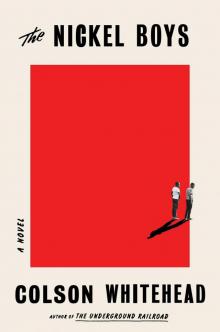 The Nickel Boys
The Nickel Boys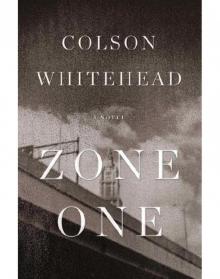 Zone One
Zone One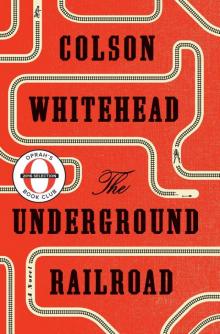 The Underground Railroad
The Underground Railroad The Colossus of New York
The Colossus of New York The Intuitionist
The Intuitionist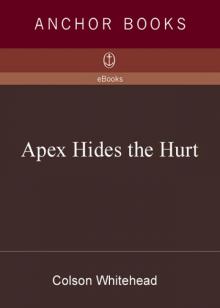 Apex Hides the Hurt
Apex Hides the Hurt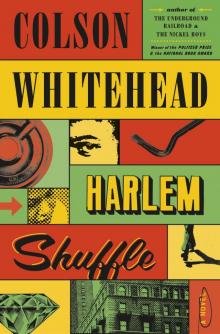 Harlem Shuffle
Harlem Shuffle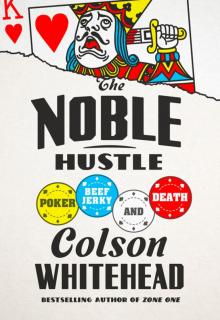 The Noble Hustle
The Noble Hustle